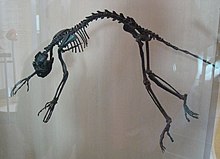| Adapiformes | |
|---|---|

| |
| Notharctus tenebrosus | |
| Scientific classification | |
| Domain: | Eukaryota |
| Kingdom: | Animalia |
| Phylum: | Chordata |
| Class: | Mammalia |
| Order: | Primates |
| Suborder: | Strepsirrhini |
| Infraorder: | †Adapiformes Hoffstetter, 1977 |
| Superfamily: | †Adapoidea Trouessart, 1879 |
| Families | |
| Synonyms | |
Adapiformes is a group of early primates. Adapiforms radiated throughout much of the northern continental mass (now Europe, Asia and North America), reaching as far south as northern Africa and tropical Asia. They existed from the Eocene to the Miocene epoch. Some adapiforms resembled living lemurs.
Adapiforms are known from the fossil record only, and it is unclear whether they form a monophyletic or paraphyletic group. When assumed to be a clade, they are usually grouped under the "wet-nosed" taxon Strepsirrhini, which would make them more closely related to the lemurs and less so to the "dry-nosed" Haplorhini taxon that includes monkeys and apes.[4]
In 2009, Franzen and colleagues placed the newly described genus Darwinius in the "Adapoidea group of early primates representative of early haplorhine diversification" so that, according to these authors, the adapiforms would not be within the Strepsirrhini lineage as hitherto assumed but qualify as a stem "missing link" between Strepsirrhini and Haplorrhini.[5] However, subsequent analysis on the Darwinius fossil by Erik Seiffert and colleagues rejects this "missing link" idea, classifying Darwinius and other adapiforms within the Strepsirrhini.[6]
Boyer et al. found that the crown Strepsirrhini likely emerged deep in the Adapiformes tree, possibly as sister of a group which include e.g. Aframonius and Notharctidae.[7] The Adapiformes are thus found not to be literally extinct (in the sense of having no living descendants), and becomes a junior synonym to the Strepsirrhini. Below is a simplified cladogram.
| Primates |
| ||||||||||||||||||
A 2018 study puts Donrussellia as sister to crown primates.[8]
- ^ "PBDB". paleobiodb.org. Retrieved 2021-08-18.
- ^ Dunn, Rachel H. (2016). "New euprimate postcrania from the early Eocene of Gujarat, India, and the strepsirrhine–haplorhine divergence". Journal of Human Evolution. 99: 25–51. Bibcode:2016JHumE..99...25D. doi:10.1016/j.jhevol.2016.06.006. PMID 27650579.
- ^ Twenty-five little bones tell a puzzling story about early primate evolution
- ^ Callum Ross, Richard F. Kay, Anthropoid origins: new visions, Springer, 2004, ISBN 978-0-306-48120-8, p. 100
- ^ Franzen, Jens L.; et al. (2009). Hawks, John (ed.). "Complete Primate Skeleton from the Middle Eocene of Messel in Germany: Morphology and Paleobiology". PLoS ONE. 4 (5): e5723. Bibcode:2009PLoSO...4.5723F. doi:10.1371/journal.pone.0005723. PMC 2683573. PMID 19492084.
- ^ Ritter, M. (October 21, 2009). "Primate fossil called only a distant relative". Associated Press. Retrieved 2012-01-12.
- ^ Boyer, Doug M.; Maiolino, Stephanie A.; Holroyd, Patricia A.; Morse, Paul E.; Bloch, Jonathan I. (2018-09-01). "Oldest evidence for grooming claws in euprimates". Journal of Human Evolution. 122: 1–22. Bibcode:2018JHumE.122....1B. doi:10.1016/j.jhevol.2018.03.010. ISSN 0047-2484. PMID 29935935.
- ^ Holroyd, Patricia A.; Silcox, Mary T.; López-Torres, Sergi (2018-09-22). "New omomyoids (Euprimates, Mammalia) from the late Uintan of southern California, USA, and the question of the extinction of the Paromomyidae (Plesiadapiformes, Primates)". Palaeontologia Electronica. 21 (3): 1–28. doi:10.26879/756. ISSN 1094-8074.